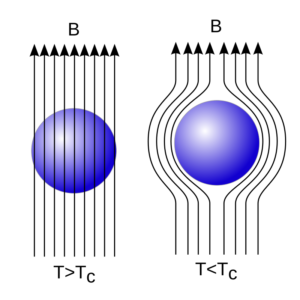Semiconductors
- The atoms of these substance have their conductivity intermediate between conductors and insulators.
- The resistivity of the substance is higher than that of conductors and lower than that of insulators.
- The conductivity is lower than conductors and higher than insulators.
- Resistance and resistivity decreases with rise in temperature, it means the temperature coefficient of the semiconductors are negative.
- The conductivity of semiconductors can be increased by adding some impurities in it.
- Example: Ge, Si, etc.
Types of semiconductors
![]()
Intrinsic Semiconductors
- A semiconductor in its natural pure form is called intrinsic semiconductor.
- These semiconductors has four electrons in its outermost orbit, and hence they are tetravalent element.
- On increasing the temperature, the valence electrons leave their position and create some vacant space, known as hole.
- The hole has a positive charge (because this is the region, from where electron shifts).
- The position of hole is filled by another electrons, and hence a new hole is created, and this new hole is again filled by next electrons. In this way hole changes its position continuously in a random manner.
- The movement of hole is just like a free electron.
- Since in pure semiconductor the number density of holes and electrons are very small, and hence the current produced in an intrinsic semiconductor can not be used as a practical purpose.
![]()
Motion of hole in intrinsic semiconductor
Structure of intrinsic semiconductor
Extrinsic Semiconductor
- When a small amount of impurity is added into a pure semiconductor, then its conductivity increases significantly.
- The process of adding impurity into an intrinsic semiconductor is known as doping.
- The semiconductor so obtained is known as doped semiconductor, impure semiconductor or extrinsic semiconductor.
- Generally 1 impurity atom is added into 108 atoms of given semiconductor.
Types of extrinsic semiconductor
![]()
n-type extrinsic semiconductors
- When a pentavalent impurity atom (Sb, As, Bi, P) is added into a pure semiconductor, then the semiconductor so obtained is known as n-type (negative type) semiconductor.
- Because a pentavalent atom has five valence electrons, and out of five four makes the covalent bond with the given semiconductor, and there is one free electrons.
- In these semiconductors each impurity atom donates one free electrons, and hence it is donor type impurity.
- Thus a semiconductor containing donor type impurity is n-type extrinsic semiconductor.
- Here the majority charge carriers are electrons.
![]()
n-type extrinsic semiconductor
p-type extrinsic semiconductors
- When a trivalent impurity atom is added into a pure semiconductor, then the semiconductor so obtained is known as p-type (positive type) semiconductor.
- Because a trivalent atom has three valence electrons, and all the three electrons make the covalent bond with the given semiconductor, and there is deficiency of one electron.
- This electron deficiency is known as hole.
- In these semiconductor each impurity atom gains one electrons, and hence it is acceptor type of impurity.
- Thus a semiconductor containing acceptor type impurity is p-type extrinsic semiconductor.
- Here the majority charge carrier are holes.
![]()
p-type extrinsic semiconductor
To know semiconductor in more detail please click here.


